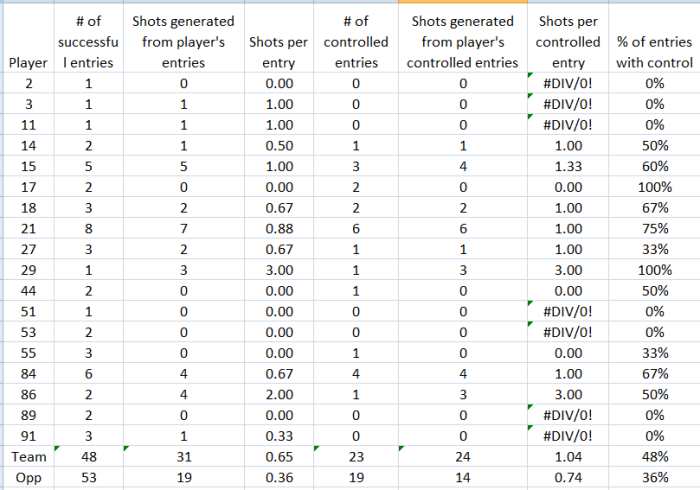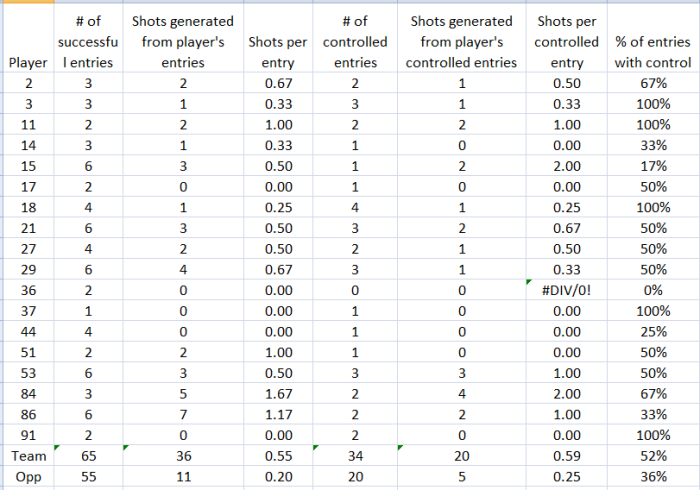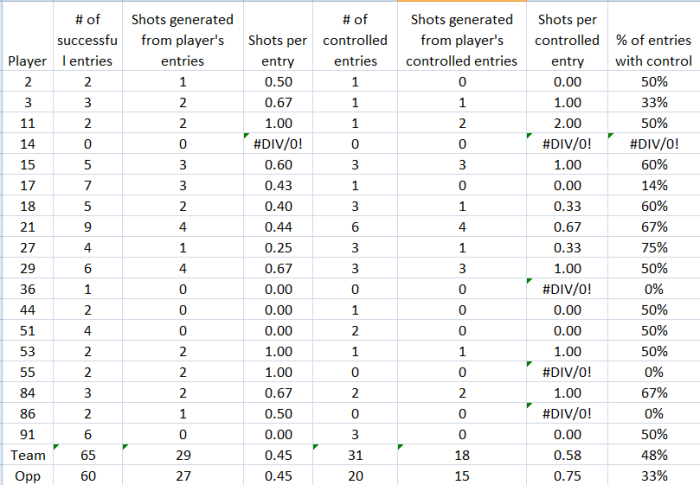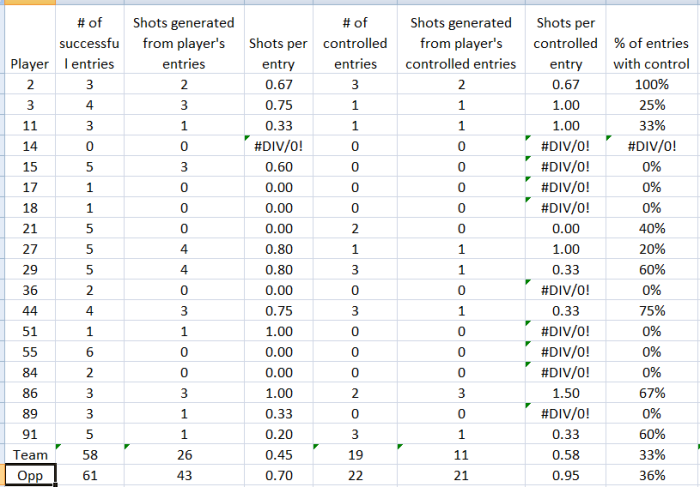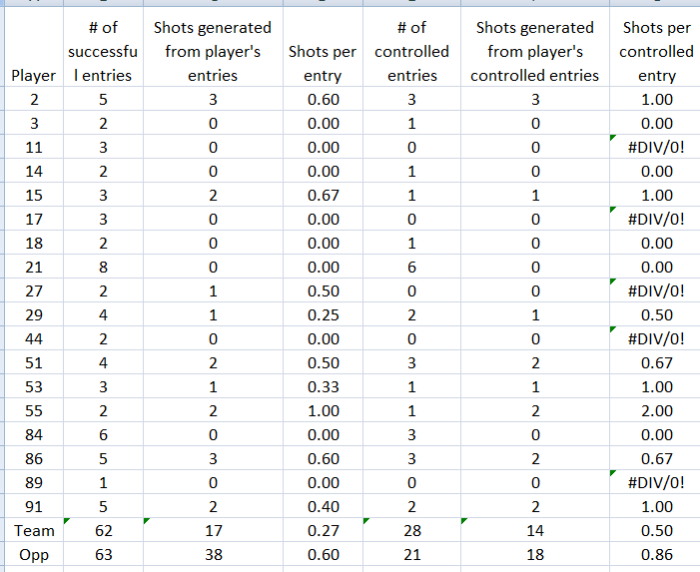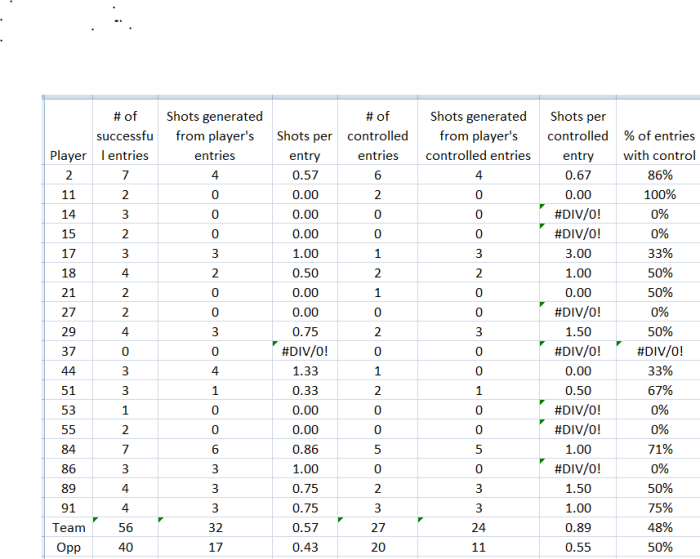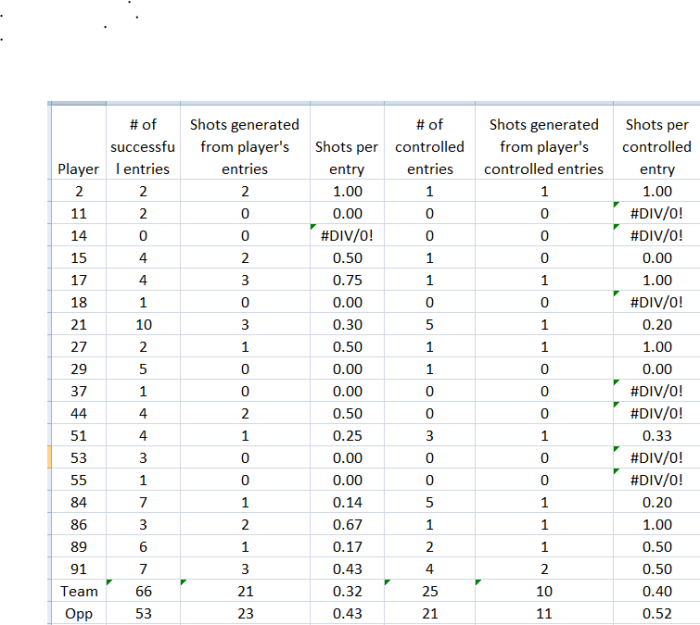Another excellent performance in the neutral zone for the Isles, who dominated by carrying in a ton while not allowing much for the Panthers. Oddly, the Panthers got a ton of shots off of dump ins this game, which is NOT normal – it’s not uncommon to see games where teams get nearly no shots off dumps in an entire game, but getting more shots per entry off dumps than off carries is bizarre.
Neutral Zone Analysis: 2014-2015 Season: Game 15 vs Colorado
Above are the neutral zone results for the Isles vs Colorado. Nearly all of this game was played with the Isles holding a big lead, so the overall results aren’t very meaningful, but again, the Isles were a lot more aggressive carrying in than at the start of the season. Kyle Okposo was particularly great in the neutral zone this game, with 6 carry-ins on 8 entries.
Neutral Zone Analysis: 2014-2015 Season: Game 14 @ Arizona
This makes two games in a row the Isles have become an extremely fast neutral zone team, preferring to carry-in rather than dump, with the Isles actually hitting above 50% this time. Most of the Isles’ neutral zone dominance came in the first (the Isles had a 68% Neutral Zone Fenwick in the first, which is ridiculous), but played slightly better than even the rest of the game, with practically the entire game being in close situations.
Basically everyone had multiple carry-ins, with the D-men accounting for 10 of them. Just a filthy game. Gotta keep this up vs the Avs on Tuesday.
Neutral Zone Analysis: 2014-2015 Season: Game 13 @ Los Angeles
Above are the results from the game vs Los Angeles. This was in theory a “Schedule Loss” game, in which the team is playing the 2nd of two games on consecutive days on the road against a rested opponent. These are games where it is normal for the unrested team to come out “flat” and get badly out played, simply due to the rest advantage.
Instead, the Isles played even in possession with the Kings, got the shootout win, and hell, actually outplayed the Kings in the neutral zone. This was probably the most aggressive neutral zone game for the Isles this year, with the team carrying in a ton – that 48% # is solid, but actually under-represents what was going on – the number was higher through two periods. And the Kings had a rougher time carrying in than the Isles.
Neutral Zone Analysis: 2014-2015 Season: Game 12 @ Anaheim
Just like how it felt in the real game (and how it looked in the possession #s), this was a tale of two games. In the first half of the game, the Isles won the neutral zone, but did so by out-entering the Ducks by a little bit. Despite doing so, they basically dumped the puck in nearly 80% of the time. In the final 30 minutes, as the Ducks outplayed the Isles, the game became more open, with more carry-ins by both teams, but more overall entries in the Ducks’ favor. And the Ducks obviously did more with their entries.
Neutral Zone Analysis: 2014-2015 Season: Game 11 @ San Jose
The above #s were practically unaffected by score effects – the Isles got some extra carries late, so they just barely won the neutral zone. But, as you know, this is how the Sharks have worked the last two years – they’re the RARE team that wins the Offensive and defensive zones, while slightly losing the neutral zone. It can work…it’s just REALLY hard to pull off and nearly every team trying it fails. The Sharks’ numbers last night are textbook for how it is when it works.
Don’t Panic! Quick Review of the Isles’ first 11 games.

Okay we’re 11 games in, so we finally now have some data to evaluate this team. 11 games isn’t much mind you, and such data – PARTICULARLY individual data – is likely to still be pretty volatile, and can change in games 12-20. But it’s enough for a start, so let’s take a look.
Team Play at 5 on 5
This is the most important thing to measure of how well the team is playing – special teams play takes up a lot less of each game (see the Boston game, where it took up only 4 minutes) and is extremely volatile and prone to lucky swings, whereas 5v5 play is much more important and is easier to evaluate and control.
Fenwick Close: 53.54%
Score-Adjusted Fenwick (classic version*): 53.34%
Save Percentage: .8975
Shooting Percentage: 8.85%
*A new method of calculating SAF has been recently posted about here, but I don’t think there’s a place listing the #s yet. For now, this shouldn’t change much.
I know a lot of people have been starting to panic about this team, especially with the current 3 game losing streak, but the numbers here suggest this is really overblown. The 5v5 Possession #s, as represented by Fenwick Close (Fenwick % in close situations at 5 on 5 play) or score adjusted fenwick (Fenwick % overall with adjustments for score situation) suggests the team has been pretty damn good – 53% is usually good for around 5th or 6th in the LEAGUE and suggests the Isles are outplaying opponents by a decent margin on average. And this is without a full healthy D corp till last game, as well as injuries to Bailey, Grabner, and Grabovski for a few games.
In short, the possession #s suggest the team is outplaying opponents on average at even strength, and the team SHOULD get better.
The issue at 5 on 5 has been goaltending, which has obviously been poor – .8975 is terrible. No one should be saying Halak or Johnson has been good overall. That said, we shouldn’t expect this to continue. Halak has years of above average play, and should be expected to do that going forward. Johnson is a bit more uncertain, but it’s unlikely he’s below a .900 goalie, as he is now.
Individual Play at 5 on 5
So how has each player done on 5v5? You can get a quick look at 5 on 5 fancystats of each player here: (No Neutral Zone #s here): http://www.behindthenet.ca/nhl_statistics.php?ds=30&s=29&f1=2014_s&f2=5v5&f5=NYI&f7=1-&c=0+1+3+5+7+8+13+14+16+15+29+30+32+33+34+45+46+63
The Good:
Nick Leddy and Johnny Boychuk have been amazing, with the Islanders dominating with the two on the ice. Mikhail Grabovski and Nikolai Kulemin have also been great overall, with Brock Nelson and Ryan Strome just behind. Hell, Matt Martin has actually been a positive possession player, of all things.
The Bad:
Let’s quickly talk about Cory Conacher, who’s been a punching bag for the Isles’ fanbase this year. I was very excited when he was signed, and still think he’s quite likely a positive force long-term. That said, his overall numbers have been quite poor, and the WOWY data suggests that he’s been extremely carried by John Tavares (the data does not suggest Conacher is hurting JT by the way, just that Conacher is doing awful without him). Moreover, the goal scoring hasn’t come. This last bit is likely fluky again – his 4% 5v5 shooting percentage isn’t likely to continue, but it’s not helping his case when his possession numbers have not been good.
Now again, 11 games is a small sample, and players who have previously been solid possession wise have had horrible 11 games before. So perhaps Conacher would turn it around on first line – or on others. I think dumping him overall over certain others on the team would be foolish – he still has potential. But it’s unquestionable he’s been poor. And he’s only had extremely easy minutes so far, so these numbers are inexcusable.
Travis Hamonic: Hamonic’s possession numbers have been a tire fire this year. He’s been a lot more passive and the pairing with Hickey has basically been a disaster. It’s a problem when he’s pulling Andrew MacDonald possession numbers….WITHOUT Andrew MacDonald!
Some of this should hopefully get better – putting him back with deHaan should improve the numbers of both if last year’s performance was for real….of course, last year’s data wasn’t a huge sample, so it might NOT have been for real. But if this team is to improve, Hamonic improving may be the real key, to give this team 3 above or well above average pairings. Not that having only two such pairings is a problem, but you get the idea.
Casey Cizikas: Cizikas-Martin was a tire fire the last two years. It STILL is a tire fire. And unlike Martin, who has made up for it when without Cizikas, Cizikas has only been okay without Martin in 30 minutes. I’m really not sure who is more to blame at this point – both are likely just not good players. If the team was willing to eschew grinders, itd be best off when Bailey and Grabner return to eliminate both from the roster.
John Tavares-Kyle Okposo: Both guys are in the green this year, but for the second straight year, despite really favorable minutes, it’s not by the dominant margins you’d hope for. Tavares isn’t a liability defensively, despite what some may think, but he used to be far better and it’s worrisome.
Overall though, it’s a good thing when only 5 of your rostered players are being outshot, and 1 of those is basically out of the starting lineup (Brian Strait). Improvements can be made, sure, but this is overall a pretty solid team so far.
Special Teams Play
At least at 5v5. Special teams have had some issues. Well, the penalty kill at least. By any measure, the power play (5v4) has been anywhere from average (by shot attempts (corsi) per 60) to well above average (by unblocked shot attempts, shots on goal, goals, etc.) so that’s not an issue.
The penalty kill however has been a disaster. Last year’s penalty kill allowed an average amount of shots, but the goaltenders couldn’t stop anything. This year’s team is allowing the most shots on goal and unblocked shot attempts per 60 in the ENTIRE LEAGUE.
The goaltenders have also been awful, yes, but that should get better based on historical track records. The shot #s are very disturbing. The Isles claimed they were tinkering with the PK after last year, and they put Greg Cronin in charge and the results have been awful.
A note on Cronin: Toronto’s PK wasn’t alarmingly bad the last two years, so I’m not saying putting him in charge was an obvious error. But the PK seems more passive and needs to cut down on shots against. The addition of Michael Grabner in a few weeks, an elite PKer, will definitely help, but the other guys should be a lot better too.
Overall
Really, the full package paints a rosier picture than the Isles’ current 6-5 record, so pay attention to the graphic atop this post. DO NOT PANIC – this is a good team. It should also get better as regression kicks in.
Neutral Zone Analysis: 2014-2015 Season: Game 10 @ Colorado
The above numbers are affected a bit by score effects, but even before the Avs put this out of hand, this was a pretty damn strong Islander neutral zone performance. The first period’s #s surpassed even that of the Jets’ game, making this two straight games where the Isles have put up a strong first period in the neutral zone, which is a good sign given that the Isles hadn’t dominated the neutral zone really this year. Meanwhile, while the carry-in rate was still not great, Nick Leddy had 6 carry-ins by himself, which is pretty insane for a D-Man.
Again, there was plenty of good in this game. This was basically the inverse of the Isles-Rangers game from 2 weeks ago (Game 3) – the Isles in that game were dominated for most of the game, but struck multiple times in a 6 minute of so span, with goaltending saving them in the rest of the game. Here the Isles dominated the Avs for most of the game, but for a 6 minute stretch in the 2nd period, and Varlamov saved the Avs for the rest of it.
This wasn’t a game that was THAT discouraging really. Gotta keep up this type of performance and we’ll win more often than not.
Neutral Zone Analysis: 2014-2015 Season: Game 9 vs Winnipeg
Above are the neutral zone numbers for the ninth game of the season vs the Jets. The Isles actually played one of their best neutral zone periods of the year in the first period, and overall played really well in the neutral zone.
Still, again we see a team that tries to dominate the neutral zone through sheer # of entries, as opposed to by carrying the puck in. Only Mikhail Grabovski really carried the puck in efficiently in this game for the Isles, and even he had one inexplicable dump in a situation where he had space to skate. This worked this game – the Isles lost due to the Kulemin major and one mistake in the third, really – but I’m curious if it can keep working in the future.
Jaroslav Halak is a good goalie. Chad Johnson is probably not.
I see people overreacting to the Islander goal situation right now. Yes the goaltending #s are really bad, and the goaltending has been really bad. We even had our first “I’m not going to talk about the goaltending” comment from Cappy! Yet people, including Cappy, are massively missing the point.
We have 10 games of goaltending data so far, 6 for Halak, 4 for Johnson. And the numbers are bad, as I said. But 10 games of goalie performance is basically nothing. It’s a drop in the bucket. And goaltenders are EXTREMELY RANDOM. Here’s how random: Both Lundqvist and Tuukka Rask are sub .900 in SV% right now. Lundqvist actually did the same thing last year and of course he turned out just fine. Goaltenders go through hot and cold streaks like no other position in hockey.
But you may say: Well Halak (and Johnson) looks bad! Well he has! But here’s the thing. Every type of player has good days and bad days, and sometimes they’ll have a few of those in a row. But for other types of skaters, if they have bad days, it may not really cost your team at all, because a few bad plays by a forward or D-Man don’t necessarily result in you being scored upon. One turnover by a D Man in the D zone for example doesn’t necessarily lead to the puck in one’s own net. By contrast, goalie mistakes are magnified. One whiff on a long distance unscreened shot is a goal against.
So given how small our samples are for each goalie, our expectations for Johnson and Halak shouldn’t really be any different than they were coming into this season. Halak was expected to have about a .915 this year (just above average for a starter). How about Johnson? Well he had a .923 in the NHL coming into today, but that is only on 1054 shots. Which isn’t much of a sample. So if we include Johnson’s AHL #s, we get around a .913 or .914. But these are if you count AHL SVs as as difficult as NHL ones, which isn’t very likely (NHL Saves are harder). So he’s probably closer to a .910 goalie. Which is below average.
Now .910 or so isn’t bad for a backup – it’s not good, but it’s acceptable. But he’s clearly a worse goalie than Halak. So we should STOP overreacting to small samples and stop playing him over Halak.
Both goalies should regress positively. Halak will more so. Give him the chance, and you’ll be rewarded.

